 |
DEPARTMENT
RESULTS |
|
|
| |
|
Goal:
Restore Minnesota's impaired waters to their best and highest use |
|
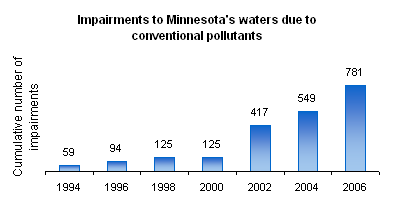 Why is
this goal important? Why is
this goal important?
Despite
decades of progress in cleaning up water pollution, hundreds of lakes,
rivers and streams in Minnesota are not clean enough.
“Impaired
waters” are those streams, rivers and lakes that currently do not meet
applicable water-quality standards and pose risks to aquatic life, people
and recreation.
Our water resources provide the base for Minnesota’s $10 billion a year
tourism industry.
The value Minnesota places on its water resources and the
importance of water resources to tourism, economic growth and community
growth make this a priority issue for the state.
Every survey by the
Pollution Control Agency and others show that citizens rank protection of
surface water as the top environmental priority.
What is the PCA doing to
achieve this goal?
Minnesota, as well as every other state in the nation, is required under the
federal Clean Water
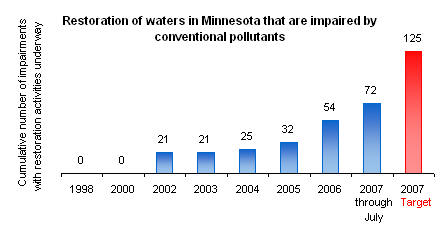 Act to: Act to:
·
identify and list surface
waters that are impaired
because they fail to
meet
water quality standards;
·
evaluate these polluted
waters to determine the
sources of the pollution
and the amount of
reduction needed for
restoration (called Total
Maximum Daily
Load
reports or TMDL reports;
and
·
make reasonable progress in cleaning up or restoring these waters.
Currently, Minnesota assesses the water quality for a small percentage of
Minnesota's rivers and lakes.
The PCA, with the assistance of the Minnesota Environmental Initiative,
consulted stakeholders to produce a policy framework and proposed
legislation that included a funding option. The Clean Water Legacy Act
passed in 2006, has helped maintain and increase progress addressing
impaired waters.
How is PCA's progress?
Overall, the PCA has identified 781 impairments to
water bodies in Minnesota due to excessive nutrients, bacteria, sediment,
ammonia, turbidity and other “conventional” pollutants. When the pollutant mercury is
included in the count, the list of impaired waters in Minnesota is nearly
2300.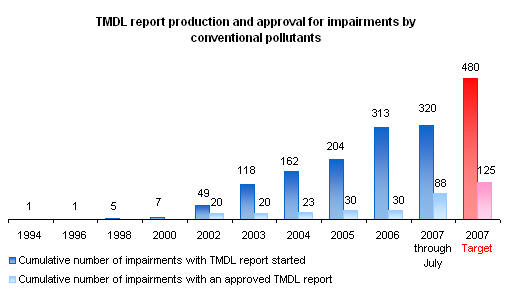 Restoration of water quality will take time, decades in some cases. Restoration of water quality will take time, decades in some cases.
The PCA does not have the capacity to produce TMDL reports
in a timely manner and the PCA is falling behind in meeting the schedule for
producing reports. The lack of capacity delays the implementation of
plans leading to the restoration of water quality.
The 2007 Legislature appropriated funds to fully implement a 10-year
monitoring strategy for the state that will result in assessing Minnesota’s
lakes and streams over a 10-year period.
|
|
Learn more at:
 The
PCA's Impaired Waters Web page The
PCA's Impaired Waters Web page
http://www.pca.state.mn.us/water/tmdl/index.html
 The
PCA’s 2003 Impaired Waters Report to the Legislature
http://www.pca.state.mn.us/publications/reports/lrwq-s-lsy03.pdf The
PCA’s 2003 Impaired Waters Report to the Legislature
http://www.pca.state.mn.us/publications/reports/lrwq-s-lsy03.pdf
 Clean
Water Legacy Act case study samples Clean
Water Legacy Act case study samples
http://www.pca.state.mn.us/publications/wq-iw3-08.pdf
|
|
Goal:
Reduce risks to humans and the environment by continually meeting all
federal and state air quality standards |
|
Why is this goal important?
Clean air means healthier people.
·
Air pollution can cause breathing problems, itchy throat and burning eyes, make asthma
and bronchitis worse and it can contribute to cancer, heart
attacks and other serious
illnesses.
·
Even healthy, athletic adults can be harmed by breathing air pollutants.
Clean
air means a healthier economy.
·
According to a 1999 study done for the Minnesota Chamber of Commerce,
violating the
federal ozone standard could cost Minnesota businesses and
consumers between $189
and $266 million a year to meet new federal requirements (1998
dollars).
·
A 2000 study by the Center for Transportation Studies at
the University of Minnesota
estimated that air pollution from transportation
sources in the Twin Cities were responsible
for nearly one billion dollars in health-related and other costs in
1998.
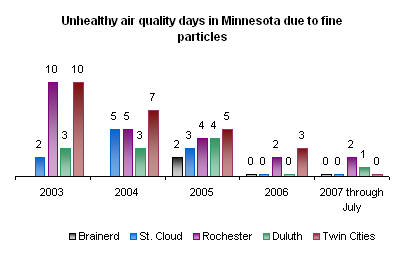 |
|
 |
What
is the PCA doing to achieve this goal?
The air pollutants of greatest concern – ozone and fine particles – come from multiple places such as:
·
power plants, factories and incinerators (called point
sources),
·
light industry and commercial and residential developments (called area
sources), and
·
cars, trucks, buses, airplanes, trains, off-road vehicles and small engines
(called mobile
sources).
The PCA wants to build on the success of our strong air quality program that
addresses pollution from point sources (e.g. power plants, factories and
incinerators). Previous efforts have successfully lowered emissions from
these larger stationary sources.
To improve Minnesota’s air quality, the PCA will work with
partners in the community to reduce air pollution. Reductions
from mobile sources will preferably come through voluntary efforts such as:
·
Seeking the early adoption of cleaner fuel and technology, and
·
Working with businesses, environmental groups, government
and other organizations
through the Clean Air Minnesota effort. (More
information about the Clean Air Minnesota
partnership is available on the
Minnesota Environmental Initiative’s Web site:
http://www.mn-ei.org/air/index.html)
How is PCA's progress?
The PCA pursues strategic goals to meet federal and state air quality standards for
ozone and fine particles and reduce the release of pollutants that
contribute to ozone and fine particles because:
·
Multiple air pollution alerts have been issued since
2001;
·
Ozone and fine
particles levels have been more than 80 percent of the new federal standard
during the past four years; and
·
The current federal air quality standard for fine
particles does not adequately protect the
public’s health.
The cool summer of 2004 provided weather conditions that did not promote
ozone formation in the Twin Cities. Correspondently, the PCA did not issue
any air quality alerts for ozone in 2004 or 2005. Fine particle
levels caused numerous air alerts throughout 2004 and 2005, as seen in the graphic.
The PCA continues to develop partnerships to reduce fine particles as well
extend air quality monitoring throughout Minnesota.
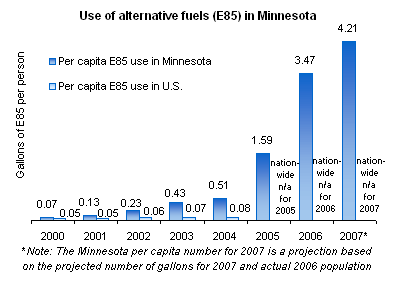
The use of the alternative fuel E85 is much greater in Minnesota than the
rest of the United States and the PCA will
continue to encourage Minnesotans to use E85 to improve air quality.
Governor Pawlenty signed an Executive Order in the fall of 2004 directing state
government to reduce air pollution. The order suggests state
agencies increase the use of E85 in their fleet of vehicles. The Pawlenty
Administration continues to energetically encourage the use of E85 by
all Minnesotans.
Use of E85 in flexible fuel vehicles in the PCA fleet increased recently, but continues at levels below the goal. Meeting the aggressive alternative fuel goal for the PCA’s fleet will
require further education of staff on the use of alternative fuels in PCA
vehicles whenever possible. The PCA also seeks to purchase E85 capable
vehicles whenever possible. Vehicles that can use E85 are the only types of
alternative fuel vehicles in the PCA’s current fleet.
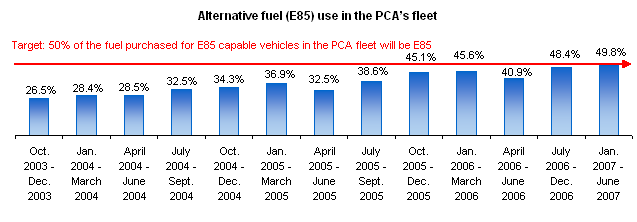 |
|
Learn more at:
 Governor Pawlenty’s Executive Order
Governor Pawlenty’s Executive Order
 Air Quality Index (AQI) for Minnesota
Air Quality Index (AQI) for Minnesota
http://aqi.pca.state.mn.us
 The PCA's
Minnesota’s Air Web page The PCA's
Minnesota’s Air Web page
http://www.pca.state.mn.us/air/index.html
 The PCA’s
2003 Air Quality in Minnesota Report to the Legislature The PCA’s
2003 Air Quality in Minnesota Report to the Legislature
http://www.pca.state.mn.us/publications/reports/lr-airqualityreport-2003.html
|
|
Goal:
Protect the environment and improve the quality of PCA services through
improvements in permitting processes |
|
Why is this goal important?
The major environmental laws in the United States and Minnesota apply regulations to
individual businesses or city facilities with facility permits to control
pollution released by businesses and wastewater plants.
A permit does not eliminate pollution coming from a facility, but it does
establish conditions that should minimize the environmental harm caused by
the pollution.
The increased complexity of environmental laws and the requirement
for
public participation
has caused the permitting
process to become difficult
to manage.
Both the U.S. Environmental Protection Agency (USEPA) and the Minnesota
Legislature have sought improvements in the timeliness of permit issuance by
the PCA.
In 2002, the Office of the Legislative Auditor reviewed the PCA’s
water quality permit program and identified a number of deficiencies (the
entire report is available at:
http://www.auditor.leg.state.mn.us/ped/2002/pe0203.htm).
What is the PCA doing to achieve this goal?
The PCA is applying a variety of process improvement tools to its permitting
programs to issue permits quicker and with greater consistency.
One
process improvement tool currently in use is the Six Sigma method.
Six Sigma will help the PCA become better informed on how to manage
processes, and more focused on maintaining efficiency and effectiveness.
This will free up resources that can be applied to new and emerging environmental matters.
The water quality permit process began using the Six Sigma method in the summer of 2003 and established a
goal to issue 90% of the permits within 180 days of receipt of the
application.
|
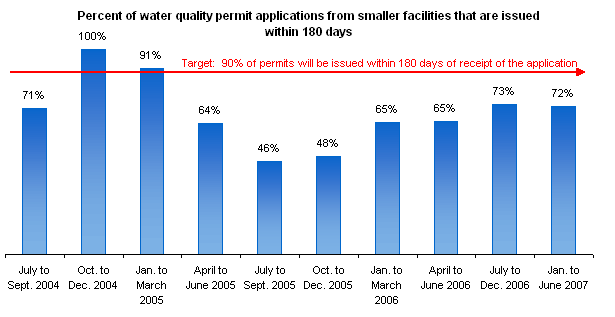
|
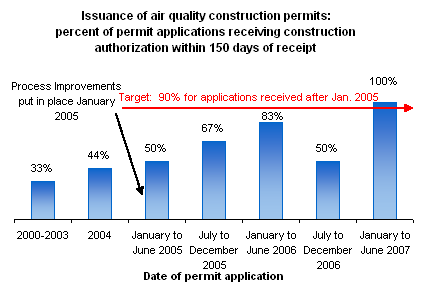 The air quality construction permit process began a Six Sigma in
early 2004 and established a goal for the process. The goal for the
process calls for 90 percent of the permit applications to receive construction
authorization within 150 days of receipt, while maintaining high quality
permit conditions. The air quality construction permit process began a Six Sigma in
early 2004 and established a goal for the process. The goal for the
process calls for 90 percent of the permit applications to receive construction
authorization within 150 days of receipt, while maintaining high quality
permit conditions.
The PCA also established goals for the issuance of air permits for larger facilities (known as
Title V permits), though not through a Six
Sigma process. The goal, established in cooperation with the U.S.
Environmental Protection Agency, is to have the initial issuance of Title V
permits completed by July 1, 2006. This goal does not apply to permits
that must be reissued in the normal course of business. The PCA achieved
this goal (see the last graph below).
The PCA continues to apply process improvement tools to other permit
processes and compliance programs, in order to improve the operations and
services of the agency. |
|
How is PCA's progress?
In the summer of 2004, the PCA began implementing the changes in the wastewater permit
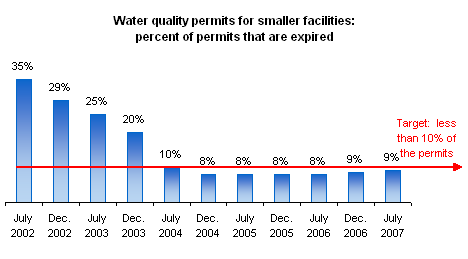 process.
The PCA has seen continued improvement in the issuance of permits for wastewater facilities since the Six Sigma process began. The PCA
will continue to review the process and make changes to achieve the process
goal. process.
The PCA has seen continued improvement in the issuance of permits for wastewater facilities since the Six Sigma process began. The PCA
will continue to review the process and make changes to achieve the process
goal.
The process improvements allow the PCA to continue achieving its goal of maintaining the percent of expired permits for smaller wastewater facilities at less than 10 percent.
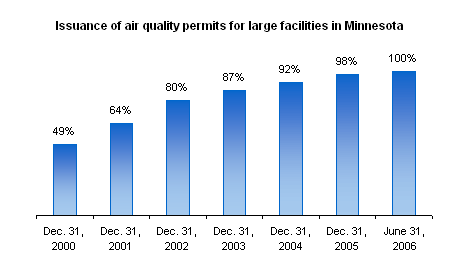 The
PCA chose to issue permits to the facilities with the largest emissions
first and extended the goal to July 1, 2006, to accommodate the final batch
of permits still in process. The percent of air quality permits for large
facilities that received their initial permit reached 100 percent by the
July 2006 deadline. The
PCA chose to issue permits to the facilities with the largest emissions
first and extended the goal to July 1, 2006, to accommodate the final batch
of permits still in process. The percent of air quality permits for large
facilities that received their initial permit reached 100 percent by the
July 2006 deadline.
|
|
|
|
Some images © 2003 www.clipart.com |
|
Last update on
08/22/2007
|
|


 Why is
this goal important?
Why is
this goal important?  Act to:
Act to: Restoration of water quality will take time, decades in some cases.
Restoration of water quality will take time, decades in some cases.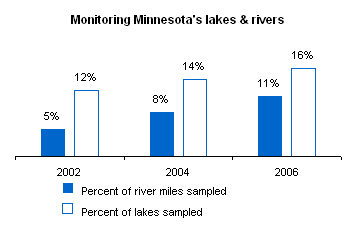

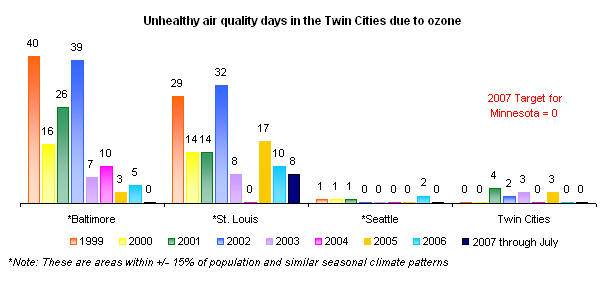





 The air quality construction permit process began a Six Sigma in
early 2004 and established a goal for the process. The goal for the
process calls for 90 percent of the permit applications to receive construction
authorization within 150 days of receipt, while maintaining high quality
permit conditions.
The air quality construction permit process began a Six Sigma in
early 2004 and established a goal for the process. The goal for the
process calls for 90 percent of the permit applications to receive construction
authorization within 150 days of receipt, while maintaining high quality
permit conditions. process.
The PCA has seen continued improvement in the issuance of permits for wastewater facilities since the Six Sigma process began. The PCA
will continue to review the process and make changes to achieve the process
goal.
process.
The PCA has seen continued improvement in the issuance of permits for wastewater facilities since the Six Sigma process began. The PCA
will continue to review the process and make changes to achieve the process
goal. T
T